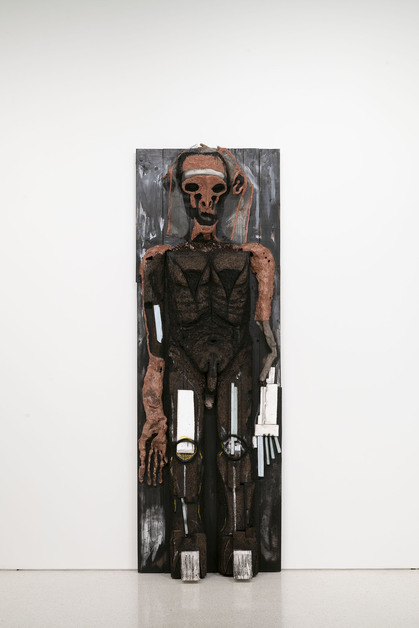-
From Current Issue
-
- Editor’s Letter Fire in the Heart
- Reviews I Gusti Ayu Kadek Murniasih
- Reviews 11th Seoul Mediacity Biennale: “One Escape at a Time”
- Dispatch Networked China
- One on One Monira Al Qadiri on Yukio Mishima
- Essays The rise of independent art spaces in pandemic-era Shanghai
- Features Tuan Andrew Nguyen
- Table of Contents
- Web Exclusives
- Archive
- Subscribe

R
E
V N
E
X
T
Installation view of the 57th Carnegie International, Carnegie Museum of Art, Pittsburgh, 2018–19. Photo by Bryan Conley. Copyright and courtesy Carnegie Museum of Art.
Ingrid Schaffner’s curatorial message for the 57th Carnegie International was to represent the meaning of the very term “international” within the “shifting terrains” of current global politics, encompassing issues of borders, nationhood and identity. Housed in the Carnegie Museum of Art in Pittsburgh, Pennsylvania, an array of objects by 32 artists and collectives from around the world chosen for this year’s exhibition occasionally prodded but mostly pleased, in keeping with Schaffner’s intention to inspire “museum joy.”
From the get-go, one was accosted by magnificent displays of beauty. On the second floor, Sarah Crowner’s handmade, Turkish Blue, thousand-tile ceramic installation evoking rippling streams was mounted across from Ulrike Müller’s massive woven fabrics, made in Mexico in collaboration with Zapotec weavers. The geometry of Müller’s colorful modernist abstractions, and the repetitive structure of Crowner’s carefully created furrows were a sharp contrast to the figurative and politically charged representations of beauty in the adjacent rooms.
Past these sizable abstract works, one entered Ghanaian-British artist Lynette Yiadom-Boakye’s room full of portraits. Her large, self-possessed, ordinary African characters, shown engaging in quotidian activities, deviate from the classical tradition of depicting distinguished subjects, such that they not only subvert the practice of European portraiture, but also reposition the notion of beauty and identity. In this context, Huma Bhabha’s Memories of the Future (2018), a monumental sculpture of a primordial male figure in the adjoining space, evokes a darker, less conventional aesthetic, drawing attention precisely because it flouts any prescribed definitions of refinement. Constructed from found materials and malleable substances like cork and Styrofoam, as with many of Bhabha’s sculptures, the towering, gargoyle-like character, with large lanky hands, and thighs that appear to be reinforced with metal, stares down at us, as if daring us to acknowledge our baser primal instincts. Simultaneously representing characteristics of early hominids and futuristic, sci-fi design elements, Bhabha’s creation became an infusion of history and an unknown terrifying future.
Situated directly in front of the primitive man was Dayanita Singh’s photograph-based installation Pothi Khana (2018). Displayed in wooden, pillar-like stands on the floor, Singh’s stacked black-and-white images of old bundles of correspondence, shot in warehouses in India and Pakistan, conjured an unknown bygone era. As one encircles the pillars, the profusion of surrounding bundles makes one speculate about the narratives concealed in their midst. Are they just mundane bureaucratic communication, or neglected personal narratives simply lost to the past?
In the antechamber above the Hall of Sculpture, a more surreal beauty emanated from Yuji Agematsu’s 365 sculptures comprising hair, toys, stones, paper, glass, and shells. The artist uses the cellophane wrapping from his cigarette packets (he is a chain smoker) to encase these small worlds of detritus that he had collected during his daily walks in different cities across the US, Japan, and the Middle East, with each sculpture representing a highly personal iconography of daily life.
Yet I couldn’t help but wonder if Schaffner’s emphasis on aesthetics was, in art critic Arthur Danto’s words,“an acknowledgement of art’s limitations when it comes to social change.” For despite the inclusion of multiple global voices whose anti-monumental edifices challenged established assumptions of “beautiful art”—such as the Vietnamese Art Labor collective’s coffee sculptures, erected as homage to the indigenous coffee planters from the Central Highlands of Vietnam, or Saba Innab’s model of a broken underground tunnel found in Gaza, meant to convey struggle, fear, subjugation and escape—the exhibition hardly addressed current events or pushed greater social awareness. Perhaps one of the most poignant works in the show was the Korean filmmaker Im Heung-soon’s collaboration with the novelist Han Kang. Im’s signature use of a two-channel format addressed, in parallel, the burden of loss on mothers during the Argentine suppression in the late 1970s and the 1980 Gwangju Uprising in South Korea. Im drew inspiration from Han’s poems as he captured painful narratives on the lifelong grief of women located on opposite ends of the world.
That said, the joy derived from the pervasive displays of beauty, or from listening to the live jazz accompanying the collective Postcommodity’s large installation From Smoke and Tangled Waters We Carried Fire Home (2018), of crushed glass, coal, and rusting steel referencing Pittsburgh’s weakened industry, aligned Schaffner’s exhibition with Danto’s belief that beauty in art is a “gesture of reconciliation with a world desperately in need of it after what it has been through in the intervening decades—a kind of aesthetic amnesty.”
The 57th Carnegie International is on view at the Carnegie Museum of Art, Pittsburgh, until March 25, 2019.
To read more of ArtAsiaPacific’s articles, visit our Digital Library.




















